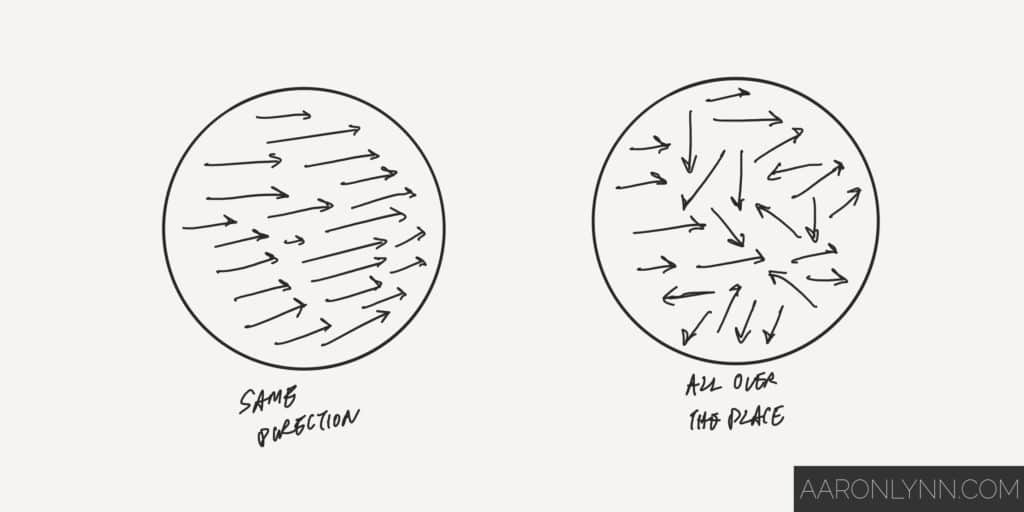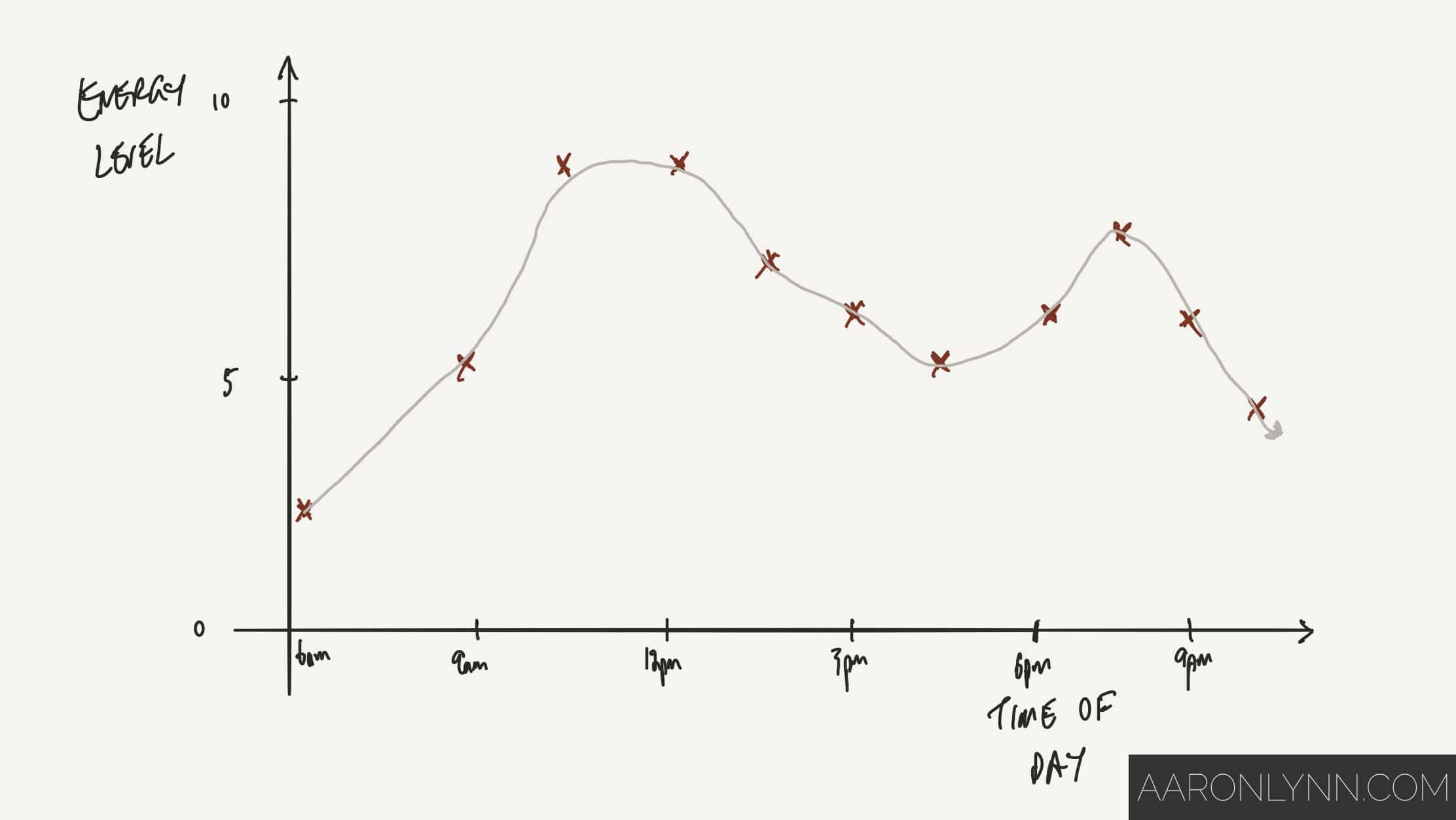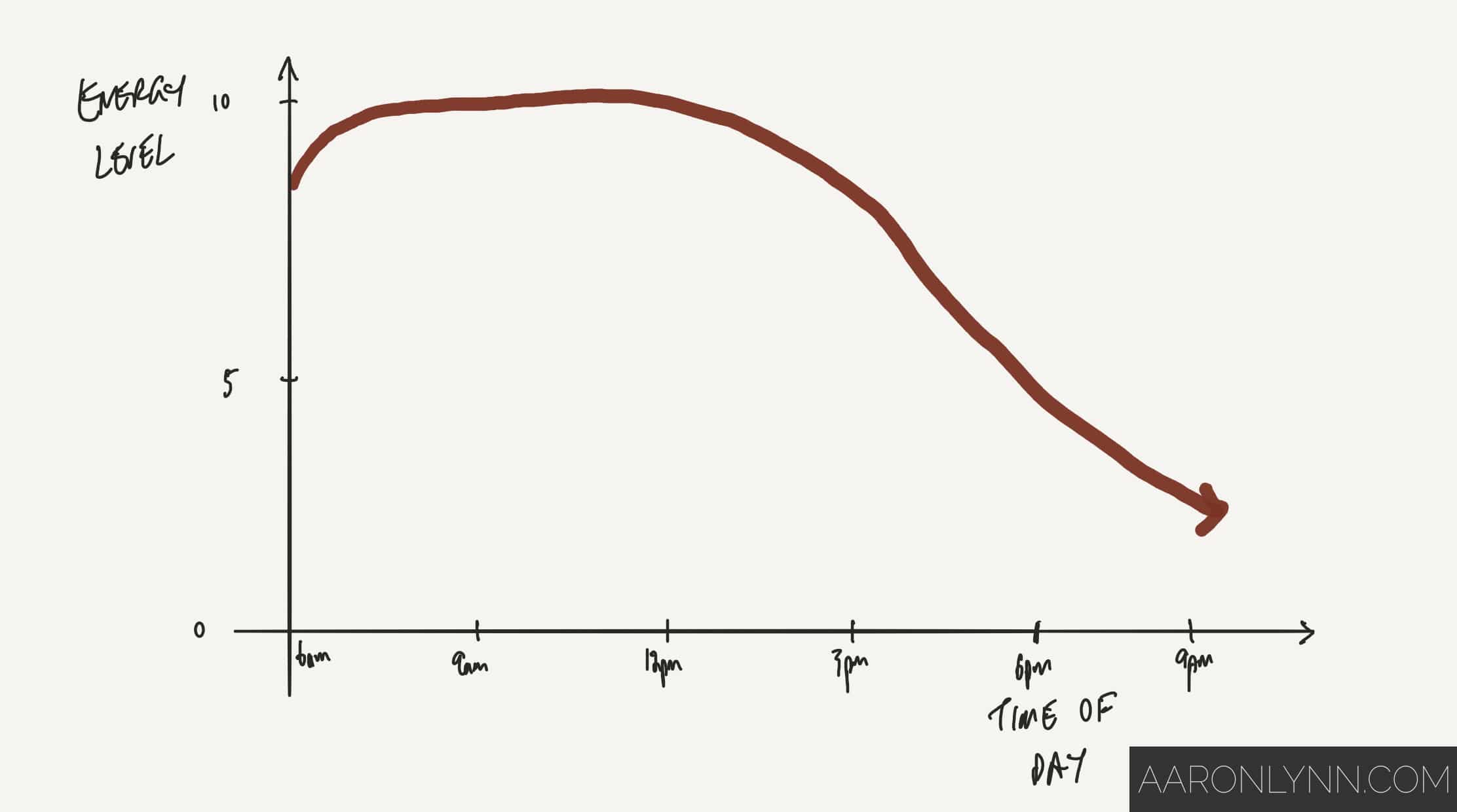
Picture this.
You wake up in the morning, and run a flawless morning ritual.
Within an hour, you are at your desk, working.
You hit your hardest and most challenging things first, and clear them with ease.
You remain productive all the way through to lunch. By 12pm, you’ve done more in a day than others will do all week.
You break for lunch.
You then glide through the afternoon with some easy (but necessary) routine admin tasks.
Late in the afternoon, you wrap up your day and prepare for tomorrow.
You hit the gym for an after-work workout, then grab some food and wind down for the day.
When it’s all done, you fall asleep easily, knowing that you’ve just had an incredibly productive day.
Sound like fantasy?
It isn’t.
Other people and I live like this every day, and you can too.
Why Bother Managing Your Energy Levels?
The main reason for managing your energy levels is obvious: you will get lots and lots of things done.
But there’s more to it than that.
Being on top of your energy levels, means that you reliably know how you will feel on a given day and can plan ahead, whether that’s for calls, meetings, work or time off.
WTF days become a thing of the past.
You will have the physical capacity to do the things you want to do.
If you want to focus on work, good energy management gives you the physical foundation you need for that.
If you want to work on a side hustle or passion project after work, you will have the energy for that.
If you want to have a late night out, you can plan for it and make sure that you have enough energy reserves to have a blast.
Having your physical energy managed simply makes everything easier to do, be it living virtuously, achieving your goals or just being at peace with yourself, knowing that you have done the best that you can.
And taking the opposite side – why would you not want to have your energy levels managed?
It makes no sense that some people would prefer to abuse their physical bodies, energy levels and feel like sh*t all the time.
What Is Energy Management?
Good energy management is having the energy you need to do the things that you want, when you want to do them.
It means that you are productive.
It means having a solid foundation in exercise, sleep, your diet, your rituals and your inner game.
Building Your Energy Management Foundation
The foundation for energy management lies in the productivity stack and in the base level of the time management stack.

These are:
- Rituals.
- Exercise.
- Diet.
- Sleep.
Stress is not part of the time management stack, but is also important for your energy levels.
Rituals
For your rituals, make sure that you have morning and evening rituals set up. These will help improve the consistency of your energy levels throughout the day.
Sleep
For sleep, I recommend doing whatever you need to in order to get good sleep. Here’s the process that I went through.
Diet and exercise
I will not cover diet and exercise in detail as I don’t consider myself an expert on these things. Instead I will tell you what works for me, and recommend some resources.
For diet I do a not-very-strict form of intermittent fasting. I don’t do it as much for the supposed health benefits, but more for the time management aspect where I don’t have to slow down in the morning to eat food.
I cook as much of my own food as possible, usually in batches. I am fine eating the same thing every day and have been for a long, long time. It saves time and is one less decision I have to make on a daily basis.
I know that what I’m eating is healthy because I will geek out with spreadsheets, calories and macros beforehand to calculate what to prepare.
For exercise I love doing compound lifts in the gym. I also do some conditioning work or just go for a walk on occasion, but not as strictly.
If you have any ongoing health issues I’ll give you the same advice that I gave myself a few years back. Find the best expert you can on the issue, do whatever you can to get it fixed, and accept that your exercise routine may not be optimal for some time.
In my case I had a spinal injury that took me out of the gym for over a year. I did the physiotherapy, the research and the reading, and then applied it. And now I have to do about thirty minutes of rehabilitation exercises every day for the rest of my life.
Yes it’s an extra thirty minutes I wish I didn’t have to spend, but it is what it is, and it works. It took about three years, and I still remember the moment I excitedly texted a weightlifting friend of mine that I was back to deadlifting 2x bodyweight 💪🏼.
Some diet/exercise resources I like:
Stress
Stress falls more into the “inner game” level of things as when we have our physical foundation covered, any stress is the result of our perception of events.
It comes back to this diagram:

The more arrows in our life are pointed in the same direction, the more congruent we are and the less stressed we are.
The best advice I have for managing stress is to:
- Work out your purpose and live by it.
- Read Meditations by Marcus Aurelius and get interested in Stoicism.
However down you feel or whatever you are going through, it probably isn’t as bad as:
- Spending most of your life at war.
- Having your children die while you were away on campaign.
- Having your wife have a public affair while you were gone.
- To come back from war only to have your best friend lead a rebellion against you.
If you put together these five things – rituals, sleep, diet, exercise, stress management – then you have an effective foundation for energy management.
You’ll find that you have the energy you need to do the things that you want to do, and “feeling tired” or “not up to it today” will become things of the past.
But is there a next level for energy management?
Why yes, there is.
Advanced Energy Management: Hero Mode
Now that you have your foundation of energy management set up, it’s time to look to the next level.
This is what is called Hero Mode.1I can’t remember which friend came up with the term, but it makes sense.
This is the productivity idea that you should work out your daily energy rhythm, then line up your hardest tasks with your energetic peaks and take breaks during the troughs.
This is something I have taught as a productivity coach and consultant, and also something I have trained teams in at companies I’ve run.
It is designed to produce optimal performance and is very effective.
Here’s how you do it.
Charting Hero Mode for Energy Management
The first step is to work out your energy patterns for the day.
You want to ask:
- What time do you wake up?
- When are you most energetic during the day? Is it:
- After waking up?
- After lunch?
- After dinner?
- In the evening?
- Some other time?
- When are you least energetic during the day?
- When do you fall asleep easiest?
The second step is to plot this on a chart, like this:
The x-axis represent the hours of your day, the y-axis represents your energy levels on a scale of one to ten.
Also make note of your office hours if you have them.2Though hopefully you have flexible remote work arrangements by now!
The third step is to look at your daily activities and work out what your hardest tasks are, whether they are for work or your personal life.
The fourth step is to do your hardest tasks when you have the most energy, and your easiest tasks (or just take a break) when you have the lowest energy.
Applying Hero Mode
You now know exactly when you are most energetic and least energetic during the day.
With this, you can start to optimise other parts of your day for even more productivity.
We’ve already mentioned placing your highest value, hardest and most important tasks at peak energy times. This is usually creative work, technical work or detailed work.
In contrast, you can now put your easy/mindless tasks at your lowest energy times. Or you can just take a break.
You can also work out optimal food timing, so that eating and digestion won’t slow down your most productive hours.
You can lastly adjust your sleep schedule so that you are resting during dead times.
Example 1: Me
Here’s an example chart of my own version of Hero Mode:
As you can see, my peak energy hours are the early morning from 6am to about noon.
After lunch I am a little less productive but can still get things done. But after 3pm, things really take a dive and I line up some easier things like reading or working out for that time.
After 8pm I am in zombie-mode which is why I prefer to sleep early 😎.
Example 2: Salesperson
Here’s an example chart from one of the salespeople I worked with recently:
Her chart is almost the opposite of mine.
She starts off zombie-like in the morning, which is why she has a negotiated flexible later start time for her work.
She starts to properly “wake up” in the early afternoon, which is usually the time she uses to call clients or work on simpler administrative tasks.
She hits her energetic peak in the evenings. This means lining up the hardest tasks she has like writing proposals and pitches or handling casework during the late hours of the night.
What To Do Next
Energy management is something that takes time to develop.
You need to build your foundation first—rituals, sleep, diet, exercise, stress management.
This may seem simple, but a twenty percent improvement in each of those areas adds up to a two-times improvement overall.
Once you’ve done that, it’s time to apply Hero Mode and take it to the next level.
If you want to find out more about other parts of the productivity or time management stacks, grab your 100% free copy of Evolution below.
- Ryan Holiday has a number of good modern books on the subject.
- I can’t remember which friend came up with the term, but it makes sense.
- Though hopefully you have flexible remote work arrangements by now!
Photo by Cláudio Luiz Castro.


